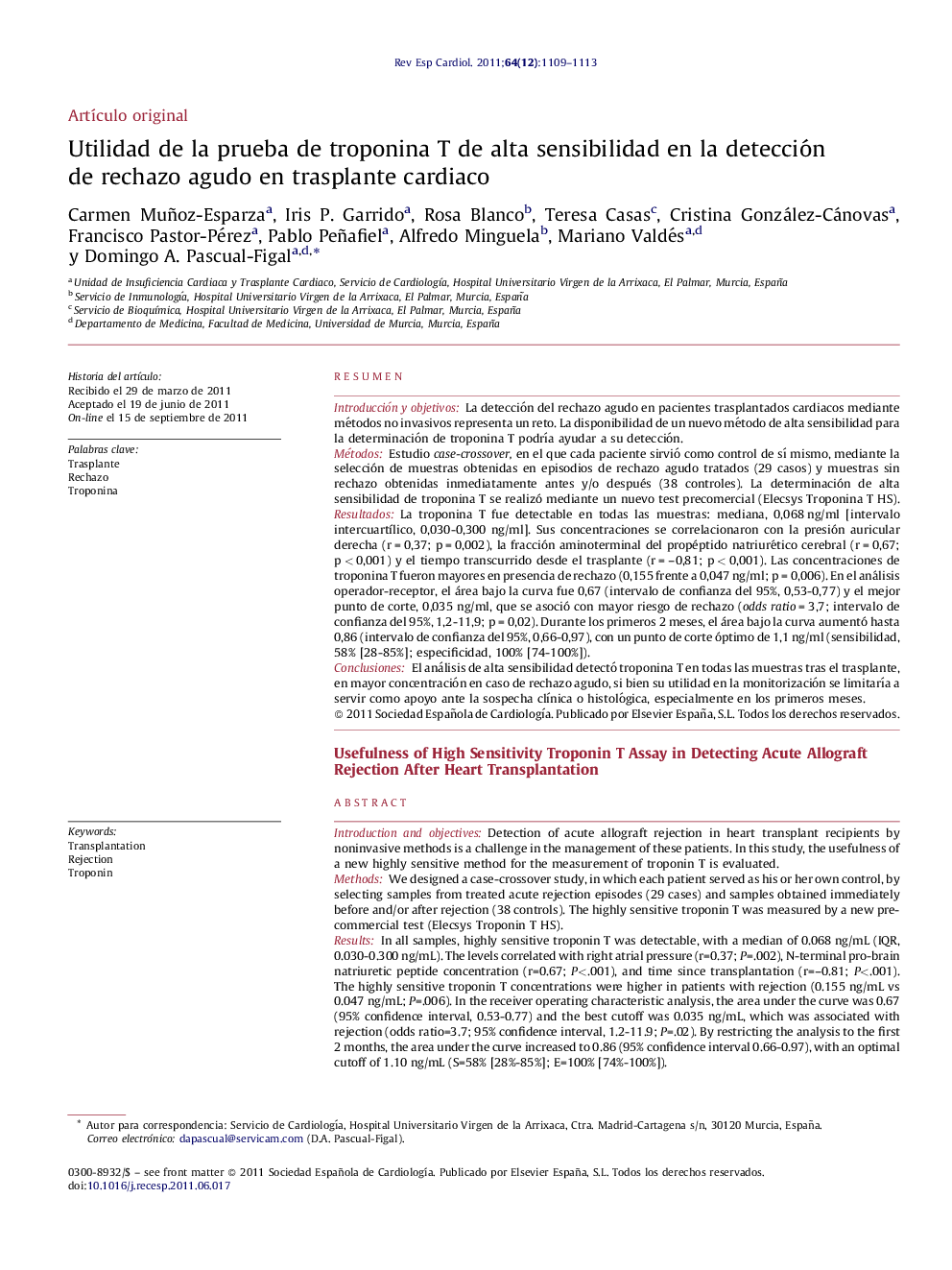| کد مقاله | کد نشریه | سال انتشار | مقاله انگلیسی | نسخه تمام متن |
|---|---|---|---|---|
| 3014663 | 1181904 | 2011 | 5 صفحه PDF | دانلود رایگان |

ResumenIntroducción y objetivosLa detección del rechazo agudo en pacientes trasplantados cardiacos mediante métodos no invasivos representa un reto. La disponibilidad de un nuevo método de alta sensibilidad para la determinación de troponina T podría ayudar a su detección.MétodosEstudio case-crossover, en el que cada paciente sirvió como control de sí mismo, mediante la selección de muestras obtenidas en episodios de rechazo agudo tratados (29 casos) y muestras sin rechazo obtenidas inmediatamente antes y/o después (38 controles). La determinación de alta sensibilidad de troponina T se realizó mediante un nuevo test precomercial (Elecsys Troponina T HS).ResultadosLa troponina T fue detectable en todas las muestras: mediana, 0,068 [intervalo intercuartílico, 0,030-0,300] ng/l. Sus concentraciones se correlacionaron con la presión auricular derecha (r = 0,37; p = 0,002), la fracción aminoterminal del propéptido natriurético cerebral (r = 0,67; p < 0,001) y el tiempo transcurrido desde el trasplante (r = –0,81; p < 0,001). Las concentraciones de troponina T fueron mayores en presencia de rechazo (0,155 frente a 0,047 ng/l; p = 0,006). En el análisis operador-receptor, el área bajo la curva fue 0,67 (intervalo de confianza del 95%, 0,53-0,77) y el mejor punto de corte, 0,035 ng/l, que se asoció con mayor riesgo de rechazo (odds ratio = 3,7; intervalo de confianza del 95%, 1,2-11,9; p = 0,02). Durante los primeros 2 meses, el área bajo la curva aumentó hasta 0,86 (intervalo de confianza del 95%, 0,66-0,97), con un punto de corte óptimo de 1,1 ng/l (sensibilidad, 58% [28-85%]; especificidad, 100% [74-100%]).ConclusionesEl análisis de alta sensibilidad detectó troponina T en todas las muestras tras el trasplante, en mayor concentración en caso de rechazo agudo, si bien su utilidad en la monitorización se limitaría a servir como apoyo ante la sospecha clínica o histológica, especialmente en los primeros meses.
Introduction and objectivesDetection of acute allograft rejection in heart transplant recipients by noninvasive methods is a challenge in the management of these patients. In this study, the usefulness of a new highly sensitive method for the measurement of troponin T is evaluated.MethodsWe designed a case-crossover study, in which each patient served as his or her own control, by selecting samples from treated acute rejection episodes (29 cases) and samples obtained immediately before and/or after rejection (38 controls). The highly sensitive troponin T was measured by a new pre-commercial test (Elecsys Troponin T HS).ResultsIn all samples, highly sensitive troponin T was detectable, with a median of 0.068 ng/L (IQR, 0.030-0.300 ng/L). The levels correlated with right atrial pressure (r=0.37; P=.002), N-terminal pro-brain natriuretic peptide concentration (r=0.67; P<.001), and time since transplantation (r=–0.81; P<.001). The highly sensitive troponin T concentrations were higher in patients with rejection (0.155 ng/mL vs 0.047 ng/mL; P=.006). In the receiver operating characteristic analysis, the area under the curve was 0.67 (95% confidence interval, 0.53-0.77) and the best cutoff was 0.035 ng/mL, which was associated with rejection (odds ratio=3.7; 95% confidence interval, 1.2-11.9; P=.02). By restricting the analysis to the first 2 months, the area under the curve increased to 0.86 (95% confidence interval 0.66-0.97), with an optimal cutoff of 1.10 ng/mL (S=58% [28%-85%]; E=100% [74%-100%]).ConclusionsTroponin T was detectable in all samples when a new highly sensitive assay was used, and at higher concentrations in the presence of acute rejection; however, the usefulness of this test in patient management is limited to support for clinical or histological suspicion of rejection, especially in the early post-transplant period.Full English text available from: www.revespcardiol.org
Journal: Revista Española de Cardiología - Volume 64, Issue 12, December 2011, Pages 1109–1113